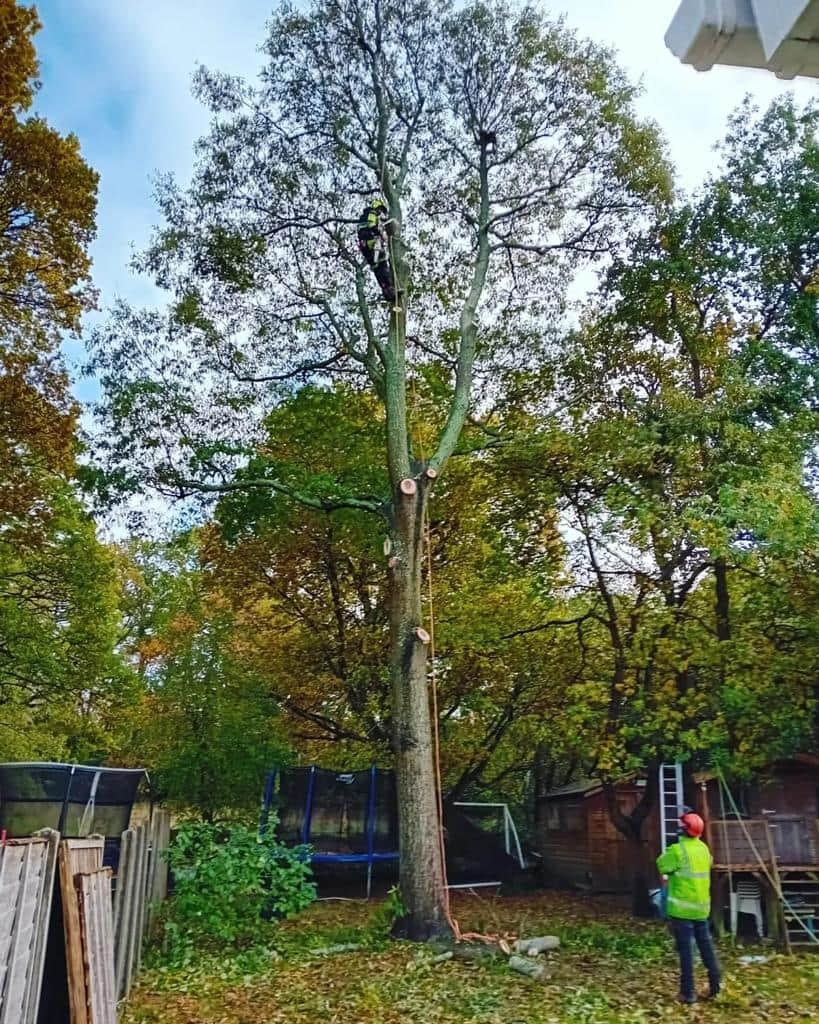Tree felling is a complex and potentially hazardous task that requires careful planning, professional knowledge, and adherence to safety guidelines. While trees are valuable assets to any landscape, there are circumstances where removal becomes necessary due to safety concerns, disease, or property development. Knowing when and how to fell a tree safely ensures minimal risk to people, property, and the surrounding environment.
At EM Tree Surgery Sharpness, we provide expert tree felling services in Sharpness, Gloucestershire, following best practices to ensure safe and efficient tree removal. Below, we outline when tree felling is necessary and the safest way to carry it out.
When Should a Tree Be Felled?
1. The Tree is Dead or Dying
A tree that has lost its structural integrity due to disease, infestation, or age can pose a serious risk. Signs that a tree is beyond saving include:
- No leaf growth during the growing season
- Large sections of dead or brittle branches
- Significant bark loss or decay
- Fungal growth at the base, indicating root rot
Dead trees become unstable over time and are more likely to collapse, making timely removal essential.
2. The Tree is a Safety Hazard
Trees that are structurally weak or leaning dangerously close to buildings, roads, or power lines present a safety risk. Warning signs include:
- Sudden tilting of the tree
- Cracks or splits in the trunk
- Heavy branches overhanging structures or pathways
- Root upheaval, which indicates instability
If a tree is at risk of falling, professional intervention is required to prevent property damage or injury.
3. The Tree is Causing Structural Damage
Large trees with invasive root systems can cause significant problems for foundations, driveways, and underground utilities. Roots can:
- Crack pavements and disrupt drainage systems
- Weaken property foundations over time
- Block underground pipes and utilities
In cases where root pruning is not a viable solution, felling the tree may be the best option.
4. The Tree is Diseased or Infested
Certain tree diseases and pest infestations can spread rapidly, threatening the health of surrounding vegetation. Common issues that may require tree removal include:
- Dutch elm disease – A fungal disease that causes wilting and death of elm trees.
- Ash dieback – A serious condition affecting ash trees, leading to brittle branches and potential collapse.
- Honey fungus – A destructive root disease that can kill trees and spread to others nearby.
If a diseased tree cannot be treated effectively, removal is often necessary to protect nearby greenery.
5. The Tree is Interfering with Land Development
Sometimes, tree removal is required to make way for property extensions, new driveways, or landscaping projects. In such cases, felling should be carried out responsibly, ensuring compliance with local tree preservation regulations.
How to Fell a Tree Safely
Tree felling should always be performed with caution to avoid accidents and ensure efficiency. The process involves several critical steps:
1. Check for Tree Preservation Orders (TPOs)
Before felling a tree, it is important to determine whether it is protected under a Tree Preservation Order (TPO) or located within a Conservation Area. Cutting down a protected tree without permission can result in legal consequences.
2. Assess the Tree and Surrounding Area
Professional tree surgeons conduct a thorough assessment before felling a tree, considering factors such as:
- The tree’s height and spread
- Nearby buildings, power lines, and roadways
- Wind direction and potential fall path
- Accessibility for equipment and removal of debris
3. Choose the Right Felling Technique
Depending on the tree’s location and condition, different felling methods may be used:
- Straight Felling – Used when there is enough space for the tree to fall in one piece.
- Sectional Dismantling – Required for trees in confined spaces; branches and trunk sections are cut and lowered in stages using ropes and rigging.
- Directional Felling – Techniques such as wedge cutting and hinge shaping help control the tree’s fall direction.
4. Use the Proper Equipment
Tree felling requires specialist equipment, including:
- Chainsaws with appropriate blade size
- Safety gear (helmets, gloves, protective eyewear)
- Climbing and rigging ropes for sectional dismantling
- Wedges and felling levers to guide the tree’s fall
5. Implement Safety Precautions
To ensure a safe felling operation:
- Establish a clear drop zone to prevent injuries or damage.
- Use ropes and pulleys to guide the tree safely.
- Have a planned escape route in case the tree falls unpredictably.
- Always have a team on site—never attempt to fell a tree alone.
6. Remove and Recycle Tree Debris
Once the tree is felled, the branches and trunk sections should be safely removed. Timber can be processed into firewood, wood chips, or repurposed for landscaping projects.
Why Hire Professional Tree Surgeons for Tree Felling?
Tree felling is a highly skilled task that requires knowledge, precision, and safety measures. Hiring professional tree surgeons ensures:
- Compliance with legal regulations and TPO restrictions.
- Safe and controlled tree removal, reducing the risk of property damage.
- Efficient debris clearance and environmentally responsible disposal.
- Expert advice on whether tree felling is the best option or if alternatives like pruning or crown reduction may be suitable.
Why Choose EM Tree Surgery Sharpness?
At EM Tree Surgery Sharpness, we provide professional tree felling services across Sharpness, Gloucestershire. Our experienced team ensures that trees are removed safely, efficiently, and in accordance with all regulations. Whether you need to remove a hazardous tree or clear space for a new project, we offer expert solutions tailored to your needs.
Conclusion
Tree felling is sometimes necessary for safety, environmental, or development reasons, but it should always be carried out with proper planning and professional expertise. Understanding when a tree needs to be removed and following best practices ensures a safe and efficient process.
If you require expert tree felling services in Sharpness, Gloucestershire, contact EM Tree Surgery Sharpness today. Our skilled team is ready to assist with all aspects of tree removal, ensuring safety and professionalism at every step.
Call us on: 01549 470 125
Click here to find out more about EM Tree Surgery Sharpness
Click here to complete our contact form and see how we can help with your trees needs.

